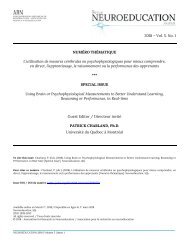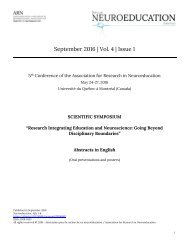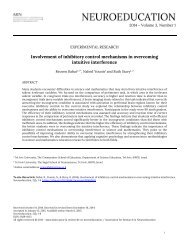Neuroeducation_2012_vol-1_no-1_full
Neuroeducation journal - Volume 1, Issue 1 (2012) - 144 pages
Neuroeducation journal - Volume 1, Issue 1 (2012) - 144 pages
Create successful ePaper yourself
Turn your PDF publications into a flip-book with our unique Google optimized e-Paper software.
Mercier, Léger, Girard and Dion<br />
Bridging the gap between cognitive neuroscience and education<br />
that learning is best understood in terms of complex “trajectories” (Lajoie,<br />
2003). These trajectories are series of events that bring cumulative changes<br />
in k<strong>no</strong>wledge and skills. They occur over radically different timescales and<br />
can be <strong>full</strong>y understood only in terms of continuities, discontinuities, iterations,<br />
false starts, etc. These trajectories rest on genetic and developmental<br />
foundations, but are dramatically influenced by human agency, both internal<br />
and external to the learner. Some crucial events constituting those<br />
trajectories are observable through actions and speech (so-called behavioral<br />
data), whereas others occur secretly within the confines of the brain and<br />
can<strong>no</strong>t be subjected to conscious examination and verbalization (so-called<br />
psychophysiological data). One the one hand, research in education relies<br />
exclusively on behavioral data. On the other hand, psychophysiological data<br />
are collected and interpreted in the context of tasks very remote from<br />
situations considered ecologically-valid in educational research.<br />
To this end, one pressing need is to obtain these psychophysiological<br />
measures in authentic contexts of human activity, and in conjunction with<br />
behavioral data typical of the contemporary study of cognition. Therefore, the<br />
objectives underlying the current study are: (1) to test a methodology which<br />
relates EEG data with data from a think-aloud protocol, and (2) to examine<br />
functional relations between psychophysiological and cognitive levels in the<br />
context of the performance of a complex cognitive task by a domain expert.<br />
The following sections describe a view of human cognition from the<br />
perspective of cognitive science, insisting on process-oriented methodologies<br />
and constructs. Then, the psychophysiological and behavioral constructs<br />
under study are presented.<br />
1.1 A multi-level architecture of human cognition<br />
Human cognition is widely understood as an information-processing system<br />
constituted of many superimposed levels (Anderson, 2002; Newell, 1990;<br />
Sun, 2006). Those levels are commonly distinguished on the basis of their<br />
implementation, that is, qualitative differences in the system by which the<br />
information is manipulated (see Table 1).<br />
ISSN: 1929-1833 © <strong>2012</strong> <strong>Neuroeducation</strong> – December <strong>2012</strong> | Volume 1 | Number 1<br />
7








